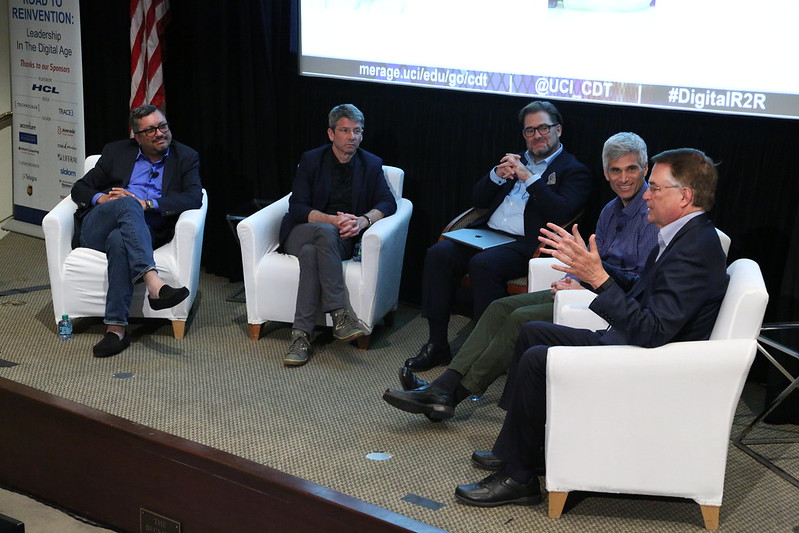Bigger, Faster, and Disruptive to the Core by CDT

On the road to reinventing themselves for the digital age, companies have been incorporating sensors, cameras, social media, data analytics, mobility, and cloud computing to transform their businesses. “You ain’t seen nothin’ yet” was a theme of the final panel at the Center for Digital Transformation’s annual conference at The Paul Merage School of Business at UC Irvine on March 24. The possibilities for digital transformation will be increasing on an order of magnitude on several dimensions.
Our physical environment will get even smarter.
“Everyone is doing analytics in advertising because that’s where the data are,” said Tom Pincince, president and CEO of Digital Lumens. “Most of the physical world isn’t instrumented—yet.” His company is working to change that. It makes light-emitting diode (LED) bulbs with embedded sensors that throw off a torrent of data about what people are doing in the illuminated space. Pincince’s company provides tools such as heat maps to visualize all these data. Customers in manufacturing and warehousing are already increasing productivity and operational efficiency within their facilities, even as they drop their lighting costs from a dollar to a dime per square foot. That’s smart lighting. Digital Lumens is growing 20 to 50 percent in an industry that’s growing only one percent annually.
Even small companies will be able to do big data
David Chaiken was on the visionary team at Yahoo! that launched Hadoop, the solution to Yahoo!’s data silo problem. Like 90 percent of companies, Yahoo!’s data sat in compartments—email, search, finance, real estate—with no means of analyzing them together. Hadoop became the platform for doing that. Chaiken, now chief technology officer at Altiscale, said that Yahoo! and its peers have become adept at big data analytics because they’ve built systems to handle the data, but most companies have not. That’s where Altiscale comes in. It’s a big-data-as-a-service provider that helps companies to extract value from big data. The key is to develop business cases for using the data to drive revenue growth. Otherwise, it’s just collecting data for data’s sake.
Big data will get even bigger.
When people talk about analyzing big data, they usually mean big sets of small object data like photographs, which are usually only a couple of megabytes in size. Larry Smarr, founding director of the California Institute for Telecommunications and Information Technology, talked about large object data like the human genome, which takes up over 300 gigabytes. Sharing these files over the Internet is no easy feat. The Corporation for Education Network Initiatives in California upgraded to 100-gigbit optical fiber so that researchers at 15 different institutions could transfer files at ten to hundred gigabits per second. As more scientists have access to a high-capacity Internet, scientific discovery should take off. Smarr expects it to revolutionize business practices and workflows, industry after industry.
More business model disruption is coming
Aron Dutta, global head of financial markets strategy for Cisco, is gearing up for the blockchain, a cryptographically secure means of exchanging value peer to peer over the Internet. Goodbye, middleman. He said it could disrupt such entrenched financial intermediaries as NASDAQ, a pioneer in electronic trading technology, and the SWIFT network that facilitates transactions between banks worldwide. A consortium of 42 financial institutions is already exploring commercial applications. Its impact could be wide-ranging, from automotive to pharmaceuticals. “If you’ve not heard about the blockchain, you will,” he said.
Being too early is indistinguishable from being late—or wrong.
How fast will the commercialization of new technologies (e.g., blockchain) and new capabilities (e.g., acting on large data sets in real time) begin disrupting business? Dutta said it will be sooner than you think. Chaiken said these things always take longer than you think. Smarr said, whatever it is, you can trace it back 15 years to curiosity driven research and collaboration among universities.
